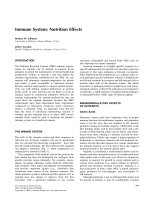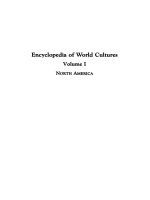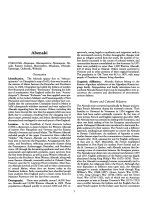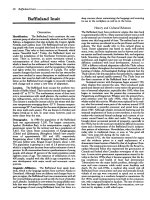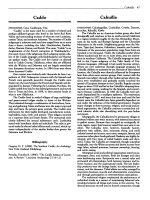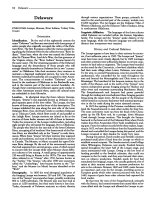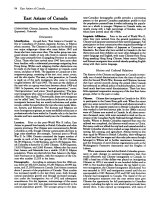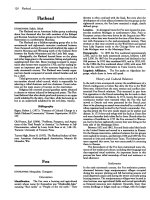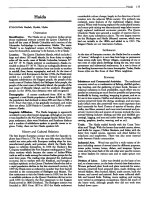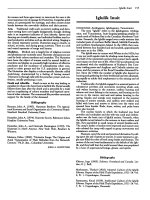Encyclopedia of World CulturesVolume I - NORTH AMERICA - L pdf
Bạn đang xem bản rút gọn của tài liệu. Xem và tải ngay bản đầy đủ của tài liệu tại đây (920.5 KB, 8 trang )
Labrador
Inuit
201
Labrador
Inuit
ETHNONYM:
Labrador
Eskimo
Orientation
'Labrador
Inuit"
refers
to
the
native
Inuit
people
of
Labrador,
a
section
of
Canada
that
is
now
within
the
provinces
of
Que-
bec
and
Newfoundland.
Scholars
have
recently
suggested
that
the
Inuit
of
Labrador
are
more
accurately
classified
as
two
groups:
the
Labrador
Inuit,
on
the
coast
of
the
Labrador
Sea
in
Newfoundland,
and
the
Inuit
of
Quebec,
on
the
coasts
of
Hudson
Bay
and
Hudson
Strait
and
in
the
interior
of
Lab-
rador.
Aboriginally,
the
Labrador
Inuit
lived
along
the
coast
of
the
Labrador
Sea
from
the
Button
Islands
south
to
Cape
Charles.
In
1772-1773
there
were
about
1,460
Labrador
Inuit
in
this
region.
Today,
they
live
primarily
north
of
Cape
Harrison,
in
the
villages
of
Postville,
Makkovik,
Hopedale,
and
Nain
and
number
about
2,000.
Also
found
in
this
region
are
people
labeled
"Settlers"
who
are
descendants
of
Inuit-
White
marriages
that
occurred
with
considerable
frequency
after
1763.
Settlers
are
generally
not
considered
Inuit
and
have
had
greater
access
to
European-Canadian
society
and
a
more
stable
socioeconomic
position
than
the
Inuit.
Aborigi-
nally,
the
Inuit
of
Quebec
were
composed
of
three
regional
bands:
the
Siqinirmiut
on
the
coastline
of
Ungava
Bay;
the
Tarramiut
in
the
northernmost
section
of
Quebec
Labrador,
and
the
Itivimiut
on
the
coast
of
Hudson
Bay
and
inland,
south
of
the
Tarramiut.
In
the
early
nineteenth
century,
they
numbered
about
2,000
and
in
1969,
numbered
3,561.
History
and
Cultural
Relations
Contacts
with
the
Labrador
Inuit
before
1700
generally
in-
volved
hostilities
with
European
whalers
and
fishermen.
Ini-
tial
relations
with
French
traders
who
began
arriving
in
1700
were
also
characterized
by
hostility,
but
eventually
gave
way
to
peaceful
trade,
with
the
Inuit
supplying
cod
and
seal
to
the
trading
posts
in
southern
Labrador.
From
1763
to
1949,
the
Inuit
were
in
contact
with
the
British,
and
over
that
period
the
culture
was
transformed
from
an
isolated
hunter-gatherer
one
to
one
reliant
on
European-Canadian
society.
The
Mora-
vian
missionaries
who
established
a
mission
in
1771
were
a
key
influence,
and
effectively
replaced
the
traditional
religion
with
Christianity
and
involved
the
Inuit
in
a
trading
post-
based
settlement
and
economic
system.
After
1926
the
Hud-
son's
Bay
Company
replaced
the
mission
store
as
the
central
trading
post.
As
regards
the
Inuit
of
Quebec,
the
first
trading
post
was
established
near
their
territory
in
1750.
From
then
on,
the
Inuit
were
slowly
drawn
into
the
European-Canadian
econ-
omy,
a
process
that
was
essentially
completed
by
the
twenti-
eth
century.
Central
players
in
this
were
the
Anglican
mis-
sionaries,
the
Hudson's
Bay
Company,
and
whaling
and
fishing
stations.
After
1900,
the
Inuit
were
caught
in
the
mid-
dle
of
fur
trade
competition
involving
the
Hudson's
Bay
Company
and
the
French
fur
company,
Rivillon
Freres,
which
further
involved
the
Inuit
in
the
fur
trade.
Since
the
1950s
in
Labrador
and
the
1960s
in
Quebec,
the
Inuit
have
been
drawn
further
into
European-Canadian
society
and
enmeshed
in
an
administrative
and
economic
framework
involving
both
the
two
provincial
and
the
national
governments.
Among
major
changes
are
the
formation
of
per-
manent
communities,
involvement
in
commercial
fishing
and
wage
labor,
compulsory
education,
and
English
or
French
re-
placing
Inuit
as
the
primary
language.
Settlements
The
Labrador
Inuit
were
seminomadic,
usually
spending
the
winter
months
in
small
villages
of
multifamily
semisubter-
ranean
dwellings
and
the
warmer
months
in
tents.
The
Inuit
of
Quebec
made
more
extensive
use
of
snowhouses
than
did
those
in
Labrador
who
used
them
only
occasionally.
Today,
the
Labrador
Inuit
are
mostly
settled
in
a
number
of
villages
and
towns.
Economy
The
traditional
economy
rested
on
the
hunting
of
sea
mam-
mals
(whales,
seals,
walruses)
on
the
coast
and
caribou
in-
land.
These
activities
were
supplemented
by
fishing,
collect-
ing
of
shellfish,
and
hunting
of
birds
and
small
animals.
Men
hunted,
women
gathered,
and
both
men
and
women
fished.
Although
there
was
no
ownership
of
land,
specific
bands
or
regional
groupings
might
have
priority
to
certain
territories
and
such
groups
might
coalesce
at
various
times
to
hunt
cari-
bou.
After
the
entrance
of
fur
traders,
trapping
became
an
im-
portant
activity,
and
the
Labrador
Inuit
became
progressively
more
dependent
on
European
trade
goods.
Travel
was
by
umiak,
kayak
(for
hunting
sea
mammals),
and
dogsled;
these
have
now
been
largely
replaced
by
motorboats
and
snowmo-
biles,
and
the
rifle
has
replaced
the
harpoon,
darts,
and
bow
and
arrow.
Marriage
and
Family
Marriage
was
preferentially
polygynous,
and
many
such
mar-
riages
were
reported
by
early
explorers,
traders,
and
missionar-
ies
in
the
area.
Postmarital
residence
was
patrilocal,
though
kin
ties
were
maintained
with
the
wife's
family
as
well.
The
typical
domestic
unit
was
either
a
polygynous
family
or
a
nu-
clear
family
with
various
other
relatives
added
on.
Winter
dwellings
housed
about
twenty
people.
Under
the
pressure
of
the
fur
trade,
European
settlers,
and
missionaries,
there
has
been
a
shift
to
smaller,
nuclear
family
domestic
units.
Sociopolitical
Organization
Neither
the
Labrador
Inuit
nor
the
Inuit
of
Quebec
were
or-
ganized
as
distinct
cohesive
units.
Rather,
the
families,
multi-
family
settlements,
bands,
and
sometimes
regional
groupings
of
bands
were
the
basic
sociopolitical
units.
Leadership
by
older
men
was
recognized
at
the
household
and
family
levels,
and
sometimes
a
broader
leadership
role
might
be
given
a
man
recognized
as
a
great
hunter
or
as
a
powerful
shaman.
Disputes
at
the
local
level
were
usually
settled
in
informal
vil-
lage
councils
composed
of
the
older
men
in
the
village.
After
establishment
of
the
Moravian
church,
the
elected
church
councils
served
as
the
governing
bodies
of
the
Labrador
com-
munities.
After
1970,
community
councils
and
various
com-
mittees
replaced
the
church
councils.
Since
1973
the
Labra-
dor
Inuit
Association
has
been
involved
in
fighting
for
aboriginal
rights
as
well
as
serving
as
a
forum
for
the
joining
of
Inuit
and
Settler
concerns.
As
regards
the
Inuit
in
Quebec,
202
Labrador
Inuit
the
James
Bay
and
Northern
Quebec
Agreement
of
1975
led
to
a
division
in
the
group
between
the
majority
who
favored
acceptance
of
compensation
for
giving
up
aboriginal
rights
and
those
who
opposed
the
settlement.
The
agreement
re-
sulted
in
the
formation
of
various
Inuit
corporations,
some
of
which
have
failed,
and
others
that
have
been
successful.
Religion
and
Expressive
Culture
The
Labrador
Inuit
and,
perhaps
more
so,
the
Inuit
of
Que-
bec
had
a
rich
mythology
and
spirit
world,
with
giants,
guard-
ian
spirits,
animal
spirits,
dwarfs,
and
other
mythological
forms.
Important
spirits
included
Torngarsoak,
the
spirit
of
seals
and
whales,
Superguksoak,
the
spirit
of
land
animals,
and
Nerchevik,
the
sea
goddess.
Shamans
were
central
figures
in
Labrador
Inuit
life.
Men
or
women
could
be
shamans,
though
they
were
more
often
men.
Shamans
invoked
their
guardian
spirits
to
cure
the
sick,
increase
hunting
success,
and
predict
and
control
the
weather.
The
Labrador
Inuit
came
under
the
influence
of
the
Moravian
missionaries
in
the
late
1700s,
and
by
the
mid-1800s,
virtually
all
had
been
con-
verted
to
Christianity.
Traditional
beliefs
and
practices
con-
tinued
for
some
years,
often
in
secret,
but
have
now
been
largely
replaced
by
Christianity.
of
the
general
Plateau
type
and
they
spoke
an
Interior
Salish
language.
Most
of
them
now
live
on
or
near
the
Colville
In-
dian
Reservation
in
northeastern
Washington
as
part
of
the
Confederated
Tribes
of
the
Colville
Reservation
and
are
gen-
erally
assimilated
into
European-American
society.
Their
cur-
rent
population
is
unknown,
but
they
probably
number
about
three
hundred.
Bibliography
Curtis,
Edward
(1911).
The
North
American
Indian.
Vol.
11.
Norwood,
Mass.
Reprint.
Johnson
Reprint
Corp.,
1970.
Teit,
James
A.
(1930).
The
Salishan
Tribes
of
the
Western
Plateau.
U.S.
Bureau
of
American
Ethnology,
45th
Annual
Report
(1927-1928),
37-396.
Washington,
D.C.
Latinos
Bibliography
Brantenberg,
Anne
B.,
and
Terje
Brantenberg
(1984).
"Coastal
Northern
Labrador
after
1950."
In
Handbook
of
North
American
Indians.
Vol.
5,
Arctic,
edited
by
David
Damas,
689-699.
Washington,
D.C.:
Smithsonian
Institu-
tion.
Saladin
d'Anglure,
Bernard
(1984).
"Contemporary
Inuit
of
Quebec."
In
Handbook
of
North
American
Indians.
Vol.
5,
Arctic,
edited
by
David
Damas,
683-688.
Washington,
D.C.:
Smithsonian
Institution.
Saladin
d'Anglure,
Bernard
(1984).
"Inuit
of
Quebec."
In
Handbook
of
North
American
Indians.
Vol.
5,
Arctic,
edited
by
David
Damas,
476-507.
Washington,
D.C.:
Smithsonian
In-
stitution.
Taylor,
J.
Garth
(1984).
"Historical
Ethnography
of
the
Lab-
rador
Coast."
In
Handbook
of
North
American
Indians.
Vol.
5,
Arctic,
edited
by
David
Damas,
508-521.
Washington,
D.C.:
Smithsonian
Institution.
Lake
The
Lake
(Senijextee,
Gens
des
Lacs)
lived
on
both
sides
of
the
Columbia
River
from
Kettle
Falls
in
northeastern
Wash-
ington
into
British
Columbia
to
the
Arrow
Lakes,
on
the
Ket-
tle
River,
and
on
the
lower
Kootenay
River.
Their
culture
was
ETHNONYMS:
Central
Americans,
Chicanos
(alternative
for
Mexican
Americans),
Cuban
Americans,
Dominicans,
El
Salvadorians,
Guatemalans,
Hispanics,
Marielitos,
Mexican
Americans,
Nicaraguans,
Puerto
Ricans
Orientation
Identification.
Latinos
in
the
United
States
are
a
diverse
group
and,
collectively,
the
second
largest
ethnic
minority
population
in
the
country.
Latino
groups
include,
principally,
Mexican
Americans,
who
are
the
largest
and
(in
historic
terms)
the
oldest
group;
Puerto
Ricans,
Cuban
Americans,
Dominicans
(from
the
Dominican
Republic)
and
in
recent
years
Central
Americans,
mainly
from
El
Salvador,
Nicara-
gua,
and
Guatemala.
Most
Latino
Americans
came
to
the
United
States
as
a
result
of
one
of
the
many
wars
of
the
last
150
years.
Puerto
Ricans
and
many
Mexican
Americans
are
descendants
of
residents
whose
homelands
were
annexed
by
the
United
States;
many
more
Mexican,
Cuban,
and
Central
American
refugees
fled
from
civil
wars
and
revolutionary
up-
heavals.
Others,
however,
came
with
or
without
government
visas
to
seek
economic
opportunities.
The
U.S.
Bureau
of
the
Census
has
used
the
term
"Hispanic"
to
designate
all
such
persons,
and
use
of
the
label
has
become
widespread.
An
His-
panic
is
anyone
in
the
United
States
who
has
a
Spanish
sur-
name
and
comes
from
a
Spanish-speaking
background.
Most
people,
however,
prefer
other
labels
that
reflect
where
they
came
from,
where
they
live,
when
they
came,
and
how
they
have
adapted
to
the
dominant
culture
of
the
United
States.
In
short,
there
are
many
Hispanics,
and
even
within
the
broader
subgroupings,
there
are
very
wide
spectrums
of
his-
torical
experience
and
tradition.
An
understanding
of
the
way
these
spectrums
have
come
into
being
requires
an
apprecia-
tion
of
the
importance
of
time,
place,
and
history.
Thus,
"Latino"
(a
generic
term
created
by
the
people
themselves)
identity
is
a
varied
and
complex
process
that
has
created
a
fas-
cinating
mosaic.
Latinos
203
Location.
Place
has
been
crucial
to
the
formation
of
the
many
Latino
identities.
For
one
thing,
geography
determines
proximity
to
cultural
roots
in
Latin
America.
Just
as
impor-
tant,
the
U.S.
government's
acquisition
and
integration
of
Latinos
was
episodic,
and
the
political
and
social
conflicts
that
resulted
from
that
process
varied
by
region
and
by
time
period.
Mexican
Americans
live
principally
in
the
southwest-
ern
states
of
California,
Texas,
Arizona,
Colorado,
and
New
Mexico,
all
of
which
were,
before
1848,
part
of
northern
Mex-
ico.
Puerto
Ricans
outside
of
the
island
territory
have
settled
mostly
in
New
York
City
and
large
Midwestern
cities.
Domin-
icans
are
located
principally
in
New
York,
Cuban
Americans,
in
Florida,
and
Central
Americans,
in
California
and
Hous-
ton.
Beyond
these
concentrations,
members
of
each
group
also
live
in
most
major
American
cities.
Demography.
Estimates
of
the
1989
population
based
on
1985
figures
indicate
that
there
were
21
million
Latinos
con-
stituting
just
under
10
percent
of
the
U.S.
population.
The
estimated
1989
populations
of
the
largest
Latino
groups
were
13
million
Mexican
Americans,
3
million
Puerto
Ricans,
1
million
Cuban
Americans,
and
4
million
other
Latin
Ameri-
can
immigrants
and
their
descendants.
In
recent
decades,
the
influx
of
immigrants
has
sharply
increased
the
total
Latino
population,
so
that
12
percent
of
Mexicans,
for
example,
are
first-generation
immigrants.
The
immigration
and
settlement
experiences
of
Latinos
have
varied
from
one
group
to
another
and
also
over
time
within
groups.
At
the
beginning
of
this
century,
Mexican
immigrants
were
largely
a
rural,
migrant
worker
population
who
joined
a
settled
population
that
pre-
dated
the
1846-1848
Mexican-American
War
by
250
years.
Since
the
1950s,
however,
Mexican
Americans
have
become
about
90
percent
urban,
concentrated
in
California
and
Texas.
Among
Puerto
Ricans
and
Cubans,
in
contrast,
initial
migration
was
primarily
to
the
urban
areas,
with
the
major
Puerto
Rican
immigration
beginning
between
the
two
world
wars
and
Cubans
mostly
arriving
after
the
1959
Cuban
Revo-
lution.
Central
Americans,
primarily
settling
in
California
and
Houston,
have
arrived
after
the
social
upheavals
of
the
1970s
and
1980s
in
their
countries.
Linguistic
Affiliation.
Spanish
is
the
national
language
of
each
of
the
nations
from
which
Latinos
emigrated
and
in
which
their
cultures
developed.
The
Spanish
spoken
by
American
Latinos,
however,
has
been
transformed
by
the
cul-
tural
changes,
mixtures
and
attitudes,
and
other
local
and
historical
accidents
and
syncretisms
that
marked
conditions
in
the
New
World.
Mexican,
Puerto
Rican,
Cuban,
and
other
national
language
habits
and
customs
differ;
features
of
American
Indian
and
African
languages,
for
just
one
exam-
ple,
have
variously
influenced
each
of
them.
Many
regional
and
urban/rural
linguistic
contrasts
exist
within
each
of
the
groups.
With
exposure
and
integration
into
American
soci-
ety,
however,
many
Latinos'
Spanish-speaking
abilities
and
styles
have
been
"Anglicized"
(been
affected
by
the
English
language),
and
many
even
forswore
the
use
of
Spanish
to
speak
English,
especially
Latinos
raised
primarily
in
the
United
States.
Language
usage
is
an
important
component
of
Latino
ethnic
identity.
Certain
Latino
populations,
especially
recent
immigrants
and
those
of
high
social
status,
derive
much
pride
from
their
ability
to
speak
fluent
Spanish.
Where
Spanish
usage
is
expected,
some
enjoy
the
opportunity
to
demonstrate
their
bilingual
flair.
For
both
social
and
political
(as
well
as
aesthetic
and
practical)
reasons,
proficiency
in
Spanish
has
become
a
key
component
in
an
emerging
ethnic
"manage-
ment"
style,
particularly
in
the
border
areas
or
where
Latinos
are
heavily
concentrated
such
as in
Los
Angeles
(Mexicans
and
Central
Americans),
New
York
(Puerto
Ricans
and
Do-
minicans),
and
Miami
(Cubans).
Speaking
Spanish
has
also
resulted
at
times
in
negative
personal
and
group
experiences,
for
it
has
been
used
by
outsiders
to
stigmatize
many
people
because
they
are
different.
History
and
Cultural
Relations
Mexicans
can
trace
their
roots
to
settlements
in
what
is
now
the
southwestern
United
States
as
early
as
1598;
this
area
was
once
the
northern
reaches
of
Mexico
proper
and
was
colo-
nized
before
the
settlement
of
New
England
by
people
from
Europe.
The
region
was
prospering
when
Anglo-Americans
began
arriving
in
the
early
nineteenth
century,
setting
in
mo-
tion
events
that
led
to
the
Mexican-American
War
of
1846-
1848.
In
the
aftermath
of
the
war,
relations
between
Anglo-
Americans
and
Mexicans
were
often
characterized
by
culture
conflict
and
intercultural
hostility.
With
increased
immigra-
tion
in
the
wake
of
the
1910
Mexican
Revolution,
the
Mexi-
can
population
burgeoned
in
all
previously
established
settle-
ments,
a
process
that
has
continued
to
this
day.
Puerto
Ricans
and
Cubans
became
associated
with
the
United
States
as
a
result
of
the
1898
Spanish-American
War.
Puerto
Rico
became
a
territory
of
the
United
States
and
now
has
limited
sovereignty
within
its
commonwealth
status.
A
migrant
stream,
increasing
considerably
after
World
War
II,
connected
Puerto
Ricans
with
the
city
of
New
York
and
brought
the
eastern
seaboard
its
first
large
Latino
population.
Like
Mexicans,
Puerto
Ricans
have
had
a
problematic
rela-
tionship
with
Anglo-Americans,
in
their
case
further
aggra-
vated
by
the
issue
of
national
independence
versus
common-
wealth
status,
which
has
strained
both
intergroup
and
intragroup
relations.
Cubans
immigrated
to
the
United
States
in
large
numbers
after
the
socialist
revolution
of
1959.
The
first
waves
were
primarily
from
the
upper-middle
and
upper
classes
and
most
immigrants
were
people
of
European
racial
backgrounds;
the
second
wave
began
in
1980
and
in-
volved
mostly
poorer,
darker-hued
"Marielitos,"
including
many
expelled
from
Cuban
prisons.
American
foreign
policy
and
actions
have
been
affected
by
events
in
Cuba,
especially
the
rise
of
anticommunism.
Large-scale
immigration
from
the
Dominican
Republic
occurred
in
the
early
1960s.
Central
Americans,
mostly
from
Guatemala,
Nicaragua,
and
El
Salvador,
made
their
entrance
in
the
late
1970s
and
early
1980s.
Coupled
with
the
changes
brought
by
Cuban
events,
the
radical
upheavals
in
Central
America
have
tended
to
generate
even
more
anticommunist
fears.
Political
and
economic
refugees
from
these
nations
have
accounted
for
a
substantial
proportion
of
recent
immi-
gration
to
the
United
States.
American
military
conquests
in
the
nineteenth
century
made
Mexican
residents
of
the
southwest
and
Puerto
Ricans
on
their
island
subjugated
peoples.
For
subsequent
migrants
from
Mexico
and
Puerto
Rico,
this
intensified
the
scorn
and
discrimination
that
has
been
the
traditional
lot
of
poor
immi-
grant
populations
in
the
United
States.
Cuban
immigrants
were
initially
comparatively
well-off
economically,
especially
204
Latinos
because
of
federal
government
subsidies
for
refugee
resettle-
ment,
which
ameliorated
economic
problems
for
them.
In
all
instances,
however,
the
dynamic
processes
of
immigration
and
adaptation
have
affected
all
groups
in
the
direction
of
as-
similation
and
acculturation.
Latinos'
relations
with
other
ra-
cial
minorities
have
been
less
antagonistic
than
with
Anglo-
Americans,
although
not
tension-free,
largely
because
Latinos
and
other
minorities
internalize
Anglo-American
stereotypes
of
each
other.
Civil
rights
measures
and
changing
public
attitudes
over
the
last
twenty-five
years
have
substan-
tially
reduced
these
interethnic
problems,
but
tensions
re-
main,
especially
with
regard
to
language
and
immigration
issues.
Settlements
Initially,
Mexicans
established
missions
and
small
rancherias
(hamlets)
in
what
is
now
the
Southwest;
in
California,
a
mission-pueblo-presidio
structure
ordered
religious,
civil,
and
military
life
for
both
American
Indians
as
well
as
the
Spanish/
Mexican
newcomers.
In
the
twentieth
century,
immigration
enlarged
some
of
these
locales,
but
more
often
new
settle-
ments
were
established
near
work
sites
such
as
ranches,
mines,
railroad
tracks,
cash
crop
fields,
and
light
industries.
The
railroad
network
helped
create
a
migrant
stream
to
the
Midwest
to
Chicago
and
other
industrial
cities.
The
word
bar-
rio
(neighborhood)
came
to
be
associated
with
these
settle-
ments
in
both
rural
and
urban
regions.
Since
the
end
of
World
War
II,
the
Latino
population
has
become
increasingly
urban,
a
trend
that
continues
today,
though
pockets
of
tradi-
tional
culture
still
exist,
especially
in
areas
such
as
New
Mex-
ico
and
south
Texas.
Puerto
Ricans
have
established
their
own
barrios in
the
eastern
and
midwestern
cities.
World
War
1I
was
a
watershed
period
as
it
created
a
demand
for
more
workers
and
soldiers,
and
Puerto
Rican
communities
ex-
panded
as
a
result.
A
unique
arrangement
facilitating
travel
between
the
mainland
and
island
has
tended
to
strengthen
Puerto
Rican
culture
and
community.
Arriving
much
later
than
the
other
Latino
groups,
Cubans
and
Central
Ameri-
cans
have
settled
mainly
in
cities.
Cubans,
in
fact,
have
achieved
major
economic
and
political
influence
in
Miami,
Florida.
The
U.S.
government
attempted
to
widely
disperse
the
recent
Marielitos
wave,
but
in
time
even
these
immigrants
gravitated
to
established
Cuban
enclaves.
Economy
Subsistence
and
Commercial
Activities.
Small
pockets
of
Mexican
Americans
who
trace
their
heritage
to
the
early
centuries
have
maintained
their
self-sufficient
ranches
and
farmlands,
but
the
majority
earn
wages
as
mine,
farm,
rail-
road,
construction,
and
light
industry
laborers.
Puerto
Ricans
have
filled
the
garment
district
and
light
industry
jobs
of
the
cities.
Cubans
arrived
with
some
money
but,
more
important,
with
skills
and
training
and
have
had
much
success
in
various
business
enterprises
and
professions.
In
recent
decades
there
has
been
a
slight
increase
in
employment
in
white-collar
serv-
ice
and
professional
occupations,
but
Latinos
generally
lag
behind
the
Anglo
population
in
employment
in
these
sectors.
A
large
agricultural
migrant-worker
population
exists
in
states
such
as
California,
Texas,
and
Florida.
Mexican
Amer-
icans
were
a
major
force
in
the
unionization
effort
by
farm
workers
in
California.
Latino
foods
vary
and
reflect
the
syncretic
Spanish/
Indian/African
mixture
noted
above,
but
beans,
rice,
and
var-
ious
stews
prepared
with
pork,
beef,
and
seafood
are
found
in
all
groups.
Chilies
are
also
widely
used
in
Latino
cuisines.
Corn
products
are
of
particular
importance
in
Mexican
and
Mexican
American
culture
(although
bread
and
wheat
flour
tortillas
have
replaced
corn
tortillas
on
many
Mexican
Ameri-
can
tables).
Cubans
and
Puerto
Ricans,
as
islanders,
gener-
ally
favor
various
seafood
dishes
characterized
by
Latino
methods
of
preparation
and
spices.
Industrial
Arts.
The
original
settlements
in
New
Mexico
produced
excellent
wood
carving,
weaving,
jewelry,
and
other
artistic
traditions.
Today,
this
Latino
bent
is
found
among
auto
paint-and-body,
upholstery,
and
seamstress
crafts-
people.
Trade.
Barrios
have
shopping
centers
and
stores
that
cater
to
the
tastes
of
the
local
population,
and
some
of
these
dis-
tricts
have
become
ethnic
centers
for
social,
cultural,
and
po-
litical
activities.
Latinos
also
use
many
of
the
malls
that
dot
urban
and
suburban
regions.
Small
family-operated
stores
are
common
among
Latino
entrepreneurs,
and
some
have
grown
into
multimillion-dollar
enterprises.
The
Cuban
American
community
has
become
a
major
economic
force
in
the
Miami
area.
Division
of
Labor.
A
shift
from
low-skilled
to
skilled
blue-
collar
jobs
has
emerged
as
an
important
trend,
as
has
the
in-
crease
of
two-wage-earner
households
with
many
women
now
having
the
dual
roles
of
breadwinner
and
breadmaker.
Al-
though
the
middle
class
has
grown,
with
many
professionals
and
educated
people,
especially
among
Cuban
Americans,
there
are
still
relatively
few
Latinos
of
middle-
or
upper-class
status.
Because
of
traditional
beliefs
and
the
Spanish
colonial
influence,
there
has
been
particular
strain
involving
changing
gender
relations
and
traditionally
defined
status
in
Latino
communities.
Many
women
have
moved
out
of
traditional
fe-
male
roles,
and
some
men
have
found
it
very
difficult
to
ad-
just
to
this
change.
Similarly,
status
distinctions
based
on
the
traditional
"patron-peon"
arrangements
are
slowly
disappear-
ing
in
an
open,
class-structured
society.
Land
Tenure.
Since
the
late
nineteenth
century,
most
of
the
extensive
land
holdings
owned
by
Mexican
Americans
has
been
lost
to
Anglo-Americans.
The
few
pockets
that
re-
main
are
in
rural
areas
such
as
New
Mexico.
As
recently
as
1966,
attempts
to
raise
public
attention
to
the
corrupt
way
in
which
these
lands
were
acquired
have
failed.
Nevertheless,
Chicano
(an
ethnic
name
for
Mexicans
in
the
United
States)
activists
still
offer
reminders
of
the
abrogation
of
the
Treaty
of
Guadalupe
Hidalgo
of
1848,
which
ended
the
Mexican-
American
War
with
assurances
that
land
rights
would
be
re-
spected.
Puerto
Ricans
have
largely
retained
ownership
of
both
large
and
small
farms
in
Puerto
Rico,
but
are
predomi-
nantly
renters
in
their
urban
U.S.
communities.
Cuban
Americans,
in
contrast,
are
rapidly
purchasing
large
blocs
of
real
estate
in
Miami.
Kinship
Kin
Groups
and
Descent.
Family
life
is
important
to
Latinos,
especially
extended
kin
networks,
even
though
An-
glo-American
influences
have
altered
traditional
patterns.
Family
interests
are
valued
over
individual
well-being.
A
syn-
Latinos
205
cretic
mixture
of
indigenous
and
Catholic
religious
beliefs
and
practices
undergirds
this
sense
of
familism.
Although
somewhat
revamped
in
the
United
States,
the
compadrazgo
(co-parenthood)
institution
of
Latin
America
is
widely
prac-
ticed
in
baptisms,
where
godmothers
and
godfathers
become
comadres
and
compadres
of
the
baptized
child's
parents.
De-
scent
is
bilateral
with
a
strong
emphasis
on
patriarchy
in
how
the
family
sets
standards
for
status,
respect,
and
authority.
Generally,
a sex
and
age
hierarchy
prevails,
and
often
elder
kin,
especially
grandparents,
are
vested
with
complete
author-
ity
in
family
affairs;
they
sometimes
take
over
primary
care
of
grandchildren
when
parents
falter.
There
are
some
intragroup
Latino
differences
in
family
structure
that
stem
from
time,
place,
and
history.
For
example,
female-headed
households
are
more
common
among
Puerto
Ricans;
Mexican
Americans
have
larger
families
on
average,
and
Cuban
Americans
tend
to
have
the
smallest
families.
Mexican
Americans
in
rural
en-
claves
in
south
Texas
and
New
Mexico
generally
embrace
tra-
ditional
family
practices
and
beliefs,
such
as
are
found
in
Mexico
proper.
Marriage
and
Family
Marriage.
Each
person
is
allowed
to
seek
his
or
her
own
mate,
but
traditionally
the
elder
family
members
keep
close
watch
to
make
sure
that
the
choice
is
an
appropriate
one.
The
average
age
of
marriage
has
increased
lately,
but
typically
it
is
lower
than
the
overall
average
in
the
United
States.
Separate
Latino
groups
have
their
own
marriage
customs,
but
even
with
American
innovations,
the
wedding
and
celebrations
are
large,
well-attended,
often
catered
affairs
hosted
by
the
bride's
family.
Postmarital
residence
is
almost
always
neo-
local,
although
financial
necessity
allows
for
temporary
living
arrangements
with
either
the
bride's
or
the
groom's
parents.
American-born
Latinos
who
are
upwardly
socially
mobile
tend
to
intermarry
more
with
Anglos,
and
exogamous
mar-
riage
is
slightly
more
common
among
Latinas
of a
higher
status.
Domestic
Unit.
Modernization
and
Americanization,
of
course,
have
changed
Latino
households.
Nevertheless,
the
sense
of
obligation
and
responsibility
that
one
owes
to
family
elders
and
parents
remains.
This
takes
many
forms,
but
em-
phasizes
affording
them
respect
and
caring
for
them
until
death.
Machismo,
or
manliness,
is
among
the
traits
associ-
ated
with
the
patriarchy
complex,
and
male-female
relations
are
often
conditioned
by
the
public
assertion
of
male
control,
especially
the
positive
qualities
of
providing
care
and
protec-
tion
for
one's
home
and
family.
These
practices
are
tempered
somewhat
by
Marian
Catholic
ideology
which
places
females,
especially
mothers
and
wives,
in
an
exalted
position.
Inheritance.
Land
and
property
is
usually
transferred
to
the
eldest
son,
although
senior
females
also
have
rights.
Most
traditional
practices
in
the
area,
however,
have
given
way
to
American
practices.
Socialization.
Social
class
differences
account
for
consid-
erable
variation
among
the
Latino
groups
in
their
approaches
to
child
rearing.
But
beliefs
in
personal
honor,
respect
for
the
aged,
and
proper
courtship
behavior
are
still
stressed
by
many
people
in
all
groups.
The
bulk
of
the
population
follows
work-
ing-class
practices,
and
new
immigrants
attempt
to
continue
native
ways.
Social
and
economic
pressures
on
family
life,
however,
have
weakened
parental
control
in
many
communi-
ties,
with
juvenile
and
adolescent
street
peers
taking
on
many
tasks
of
socialization.
Sociopolitical
Organization
Social
Organization.
There
are
a
small
number
of
well-
to-do
Latinos,
with
Cuban
Americans
disproportionately
represented
among
them.
The
number
of
Latino
entrepre-
neurs
and
professionals
in
the
middle
class
is
also
relatively
small,
but
increasing.
The
majority
of
the
population
is
di-
vided
almost
equally
between
American-born,
working-class
families
and
immigrant
families
headed
by
low-skilled
and
unskilled
workers.
"Mestizaje,"
the
mixing
and
amalgamation
of
Spanish,
Indian,
and
African
racial
groups,
was
widespread
in
various
places
in
Latin
America.
Terms
like
mestizo,
mulatto,
cholo,
moreno,
and
castizo
were
originally
created to
categorize
the
subtle
differences
in
the
"hybrid"
population
mixes.
Thus,
there
is
a
wide
spectrum
of
racial
appearance
reflected
within
the
Latino
communities.
Historically,
such
diversity
has
cre-
ated
considerable
strain
and
conflict.
As
racial
appearance
and
racial
attitudes
became
increasingly
important
in
inter-
personal
relations,
people
were
made
to
feel
different
on
the
basis
of
their
racial
appearance.
A
kind
of
"pigmentocracy"
was
established
throughout
much
of
Latin
America
to
shape
people's
attitudes-about
others
and,
even
more
important,
about
themselves.
Feelings
of
inferiority
and
superiority
were
implanted
in
people's
heads
and
these
feelings
helped
deter-
mine
the
extent
to
which
they
would
have
a
common
heritage
and
shared
experiences.
Political
Organization.
Latinos
vary
widely
in
their
access
to
and
inclination
toward
participation
in
the
political
proc-
ess
in
the
United
States.
Undocumented
and
documented
aliens-who
are
unable
to
vote-are
limited
to
publicizing
their
concerns.
Many
avoid
even
these
activities
out
of
fear
of
deportation.
Recent
immigrants
often
follow
political
devel-
opments
in
their
homelands
more
closely
than
those
of
the
United
States.
Latinos
are
sharply
underrepresented
in
fed-
eral,
state,
and
local
governments
despite
the
efforts
of
orga-
nizations
such
as
NALEO
(National
Association
of
Latino
Elected
and
Appointed
Officials),
which
have
attempted,
with
some
success,
to
unite
all
Latinos
and
especially
to
find
common
ground
for
political
lobbying.
Latinos
are
also
pro-
foundly
divided
in
political
orientations.
Cuban
Americans
are
largely
drawn
to
conservative
causes,
especially
on
foreign
affairs
issues.
A
majority
of
Mexican
Americans
and
Puerto
Ricans
align
themselves
with
the
Democratic
party,
but
the
issues
that
concern
them
in
part
reflect
their
regional
differ-
ences.
Two
political
positions
that
Latinos
largely
support
are
improved,
less
punitive
immigration
legislation
and
increased
support
for
bilingual
education
programs.
Social
Control
and
Conflict.
Traditional
familial
con-
straints
and
respect
for
authority
and,
of
course,
the
local,
state,
and
federal
legal
systems
operate
to
maintain
social
order.
But
there
is
still
a
residue
of
instability
and
uncertainty
remaining
from
the
past
and
especially
from
the
negative
side
effects
of
immigration.
Racial
diversity
has
contributed
to
continuing
social
conflict,
and
frictions
with
major
social
control
institutions,
such
as
schools
and
police,
have
also
persisted.
206
Latinos
Local,
regional,
and
sometimes
national
efforts
to
resist
and
change
discriminatory
practices
are
common
occur-
rences.
The
Latino
social
movements
of
the
1960s,
however,
have
resulted
in
continued
improvements
in
such
areas
as
bi-
lingual
education,
increased
hiring
in
public
jobs,
and
a
rise
of
public
interest
in
Latino
issues.
The
wars
of
the
past
con-
tinue
to
affect
Latino-Anglo
relations
in
the
United
States:
Mexican
Americans
deplore
violations
of
the
Treaty
of
Gua-
dalupe
Hidalgo;
many
Puerto
Ricans
aspire
to
statehood
or
independence;
Cubans,
because
of
its
recency,
talk
of
recap-
turing
the
'revolution";
and
Central
Americans
lament
the
contemporary
wars
from
which
many
are
refugees.
Religion
and
Expressive
Culture
Religious
Beliefs.
As
with
the
Spanish
language,
Roman
Catholicism
dominates
throughout
Latin
America,
but
varies
in
form
and
practice
from
country
to
country
and
region
to
re-
gion,
owing
largely
to
syncretic
mixing
with
other
religious
traditions.
Latinos
in
the
United
States
also
display
this
vari-
ation,
with
patron
saints,
special
days
of
observance,
and
ritu-
als
of
baptism,
marriage,
and
death
varying
among
different
Catholic
Latino
groups.
For
example,
the
Virgin
of
Guadalupe,
a
brown-appearing
icon
associated
with
the
Indian-Mestizo
segment
of
the
population
in
Mexico,
is
of
lit-
tle
interest
among
Cuban
Americans
and
Puerto
Ricans,
and
santeria
(worship
of
African
gods
clothed
in
Catholic
dogma)
beliefs
and
practices
in
those
groups
are
far
less
common
among
Mexican
Americans.
Although
most
Latinos
adhere
to
the
Catholic
church,
evangelical
Protestantism
has
gained
many
followers
in
recent
decades.
Arts.
Folk
art
traditions
in
murals,
woodwork,
music,
oral
lore,
and
pottery,
as
well
as
modem
stylized
forms
reinter-
preting
these
traditions,
characterize
a
rich
artistic
cultural
el-
ement.
Afro-Cuban
and
Puerto
Rican
percussion
instru-
ments
and
rhythms
have
effected
a
new
American
salsa
style
of
music.
Recently
an
increase
in
Latino
American
plays,
the-
ater,
and
cinema
has
brought
a
new
awareness
to
the
popula-
tion;
particularly
important
are
the
sociopolitical
content
of
these
works,
such
as
demonstrated
by
the
early
Teatro
Cam-
pesino
(Peasant
Theater)
"actos"
(politically
charged
skits)
during
the
United
Farm
Worker
movement
in
California.
Medicine.
Traditional
folk
practices
continue
to
vie
with
Western
medicine
in
many
Latino
communities,
although
most
Latinos
seek
medical
help
for
serious
injuries
or
acute
illness.
Still,
one
can
readily
find
curanderos
(folk
healers)
who
offer
old
indigenous
and
syncretized
herbal
and
physical
remedies
for
virtually
any
ailment.
Death
and
Afterlife.
Latinos
generally
subscribe
to
Chris-
tian
beliefs
of
an
afterlife
in
which
one
is
rewarded
or
pun-
ished
for
having
led
a
good
or
evil
life.
The
significance
of
death
and
afterlife
is
symbolized
most
clearly
in
Mexican
American
celebrations
of
El
Dia
de
Los
Muertos
(literally
'Day
of
the
Dead,"
but
known
as
All
Saints'
Day
in
English),
which
feature
masks,
dolls,
and
cakes
adorned
with
figures
of
skulls
and
skeletons.
Funeral
rites
vary
as
other
syncretized
re-
ligious
ceremonies
do
among
Latinos,
but
typically
include
large
gatherings
of
real
and
fictive
kin.
Bibliography
Bordas,
G.,
and
M.
Tienda,
eds.
(1985).
Hispanics
in
the
U.S.
Economy.
New
York:
Academic
Press.
Boswell,
Thomas
D.,
and
James
R.
Curtis
(1984).
The
Cuban-American
Experience.
Totowa,
N.J.:
Rowan
&
Allanheld.
Hendricks,
Glenn
L.
(1974).
The
Dominican
Diaspora:
From
the
Dominican
Republic
to
New
York-Villagers
in
Transition.
New
York:
Teachers
College
Press.
Moore,
Joan
W.,
and
Harry
Pachon
(1985).
Hispanics
in
the
United
States.
Englewood
Cliffs,
N.J.:
Prentice-Hall.
Padilla,
Felix
(1987).
Puerto
Rican
Chicago.
South
Bend,
Ind.:
University
of
Notre
Dame
Press.
Rodriquez,
Clara
(1989).
Puerto
Ricans:
Born
in
the
U.S.A.
Boston:
Unwin
Hyman.
Vigil,
James
Diego
(1984).
From
Indians
to
Chicanos:
The
Dy-
namics
of
Mexican
American
Culture.
Prospect
Heights,
Ill.:
Waveland
Press.
JAMES
DIEGO
VIGIL
Lillooet
ETHNONYMS:
Chin
Nation,
Lilowat,
Lil'wat
The
Lillooet
were
one
of
the
four
principal
tribes
in
the
interior
plateau
of
British
Columbia.
They
are
sometimes
re-
ferred
to
as
the
Lower
Lillooet,
including
the
Douglas
and
Pembroke
Meadows
bands,
and
the
Upper
Lillooet,
including
all
other
bands.
They
occupied
the
southwestern
part
of the
province
in
the
basin
of
the
Lillooet
River,
the
upper
part
of
Harrison
Lake,
and
environs.
In
the
early
1900s
there
were
thirteen
bands,
with
the
number
reduced
to
ten
today.
There
were
many
villages,
each
governed
by
a
hereditary
band
chief.
Today
there
are
about
twenty-five
hundred
Lillooet
living
on
reserves
in
their
tradi
tional
territory
and
in
nearby
cities.
The
Lillooet
speak
an
In-
terior
Salishan
language
related
to
the
languages
of
the
Okanagon,
Shuswap,
and
Thompson
Indians.
Lillooet
culture
displayed
many
features
typical
of
Northwest
Coast
groups:
the
potlatch,
clan
names,
mythol-
ogy,
prestige
afforded
the
wealthy
and
generous,
and
totem
poles
in
some
areas.
They
had
several
types
of
dwellings-
long
plank
houses,
winter
earthlodges,
and
summer
bark-
or
mat-covered
lodges.
Salmon
and
other
fish
were
the
basis
of
the
economy,
and
numerous
animals
(bear,
sheep,
caribou,
deer,
and
small
mammals)
were
hunted
and
trapped,
and
ber-
ries
and
fruit
were
gathered.
Warfare
with
other
groups
was
unusual,
with
intensive
intertribal
trade
the
more
typical
state
Lipan
Apache
207
of
affairs.
The
guardian
spirit
vision
quest
was
important,
as
was
a
long
training
period
for
adolescents
in
preparation
for
adulthood.
Bibliography
Stryd,
Arnoud
H.,
ed.
(1978).
Reports
of
the
Lillooet
Archaeo-
logical
Project.
Number
1.
Introduction
and
Setting.
National
Museum
of
Man,
Mercury
Series,
Archaeological
Survey
of
Canada,
Paper
73.
Ottawa.
Teit,
James
A.
(1906).
The
Lillooet
Indians.
American
Mu-
seum
of
Natural
History,
Memoir
no.
4,
193-300.
Teit,
James
A.
(1912).
"Traditions
of
the
Lillooet."
Journal
of
American
Folklore
25:287-371.
Lipan
Apache
ETHNONYMS:
Chipayne,
Flechas
de
Palo
Apaches,
Hipandis,
Ipande,
Lipane,
Lipianis,
Lipyane,
Lypanes,
Ypande
Orientation
Identification.
The
Lipan
Apache
had
ceased
to
exist
as
a
separate
tribe
by
1905,
when
the
last
of
them
moved
to
the
Mescalero
Apache
Indian
Reservation
in
south-central
New
Mexico.
Anthropological
fieldwork
with
Eastern
Apache
did
not
begin
until
Morris
Opler's
work
in
the
1930s,
by
which
time
the
Lipan
were
virtually
extinct.
See
the
entry
on
the
Mescalero
Apache
for
all
contemporary
information.
The
following
is
a
brief
historical
sketch
reconstructed
from
ar-
chival
documents
and
secondary
sources.
Usually,
the
name
"Lipan"
is
said
to
have
come
from
the
name
of
a
grand
chief-
tain
with
a
version
of
the
suffix
-nd6,
"The
People,"
ap-
pended.
Archival
documents,
however,
lead
to
an
equally
plausible
explanation,
since
early
mention
(eighteenth
cen-
tury)
of Lipans
is
often
spelled
with
one
of
the
variations
of
"Lipiyane."
Liti
is
the
Apachean
word
for
"horse,"
and
'
iyane
is
the
word
for
"bison";
thus,
their
name
could
well
have
re-
ferred
to
their
primary
subsistence
pattern:
that
of
following
bison
herds
on
horseback.
Location.
In
the
early
eighteenth
century,
Lipan
Apache
were
in
central
and
western
Texas,
from
approximately
the
Trinity
River
(east
of
present-day
Waco,
Texas)
westward
to
the
Pecos
River,
where
they
joined
their
Mescalero
Apache
"cousins."
They
were
reported
as
far
north
as
the
Canadian
River
in
the
Texas
Panhandle
and
as
far
south
as
the
San-
tander
area
of
Mexico.
Most
reports
of
Lipan
place
them
ei-
ther
in
the
vicinity
of
bison
herds
or
occupying
river
bottom
lands.
Like
most
Apachean
groups,
they
roamed
over
vast
areas,
but
always
they
were
reported
in
desert
or
coastal
plains
sites
rather
than
in
mountains,
as
were
some
other
Apache
groups.
In
general
they
lived
in
very
warm
to
hot
climates;
night
in
desert
areas,
however,
is
usually
cool
and
can
be
cold
in
the
winter.
linguistic
Affiliation.
Lipan
Apache,
still
spoken
by
per-
haps
two
dozen
or
so
people
on
the
Mescalero
Apache
Indian
Reservation,
is
a
Southern
Athapaskan
language.
As
such
it
can
be
understood
by
speakers
of
other
Apachean
languages,
although
most
of
them
maintain
that
Lipan
speakers
speak
more
slowly
and
with
broader
vowels
than
do
speakers
of
other
Apachean
languages.
The
Southern
Athapaskan
lan-
guages
are
related
to
other
Athapaskan
languages
spoken
on
the
north
coast
of
California
and
in
the
Pacific
Northwest,
and
through
parts
of northern
Canada
and
Alaska.
Despite
attempts
to
record
Lipan
Apache,
it
remains
largely
unknown
in
a
scholarly
sense.
The
contemporary
speakers
are
adamant
that
it
not
be
recorded
or
written,
believing
that
if
the
lan-
guage
is
meant
to
survive
them,
then
it
will
do
so,
but
that
it
is
inappropriate
for
people
to
interfere
with
a
process
directed
by
the
Creator.
Demography.
Currently
numbered
with
the
Mescalero
and
Chiricahua,
it is
difficult
to
obtain
precise
numbers
of
Lipan.
A
reasonable
estimate
is
that
there
are
fewer
than
fifty
people
alive
today
claiming
Lipan
ancestry
as
their
primary
ethnicity.
At
their
height,
they probably
numbered
no
more
than
five
thousand,
divided
into
about
a
dozen
bands.
History
and
Cultural
Relations
As
with
the
other
Apache
groups,
the
Lipan
were
engaged
in
a
protracted
struggle
over
land
use
and
settlement
patterns
with
the
Spanish,
Mexican,
and
U.S.
governments
from
the
first
mention
of
them
in
the
early
1700s
to
their
virtual
ex-
tinction
in
1905.
Prior
to
the
1700s
there
was
a
plethora
of
names
used
for
the
Apachean
people
of
eastern
New
Mexico,
western
Texas,
and
the
Panhandle;
it
is
likely,
although
not
definitively
demonstrated,
that
some
of
these
(Trementina,
Limita)
were
later
called
"Lipan."
Unlike
most
Apache,
the
Lipan
were
missionized
in
the
1700s
in
the
northeastern
reaches
of
the
Spanish
empire,
in
the
areas
of
Eagle
Pass
and
San
Antonio,
Texas.
The
missionization
effort
cannot be
termed
a
success,
for
the
missions
were
poorly
supplied
and
their
inhabitants
often
left
to
pursue
subsistence
activities
only
to
return
when
supplies
were
again
available
in
the
mis-
sions.
For
the
most
part,
the
Lipan
were
at
war
with
the
invad-
ers
until
there
were
no
longer
enough
of
them
left
to
fight.
Settlements
and
Economy
The
Lipan
were
the
most
sedentary
of
the
Apachean
groups,
for
they
planted
crops,
especially
maize.
The
Spanish
de-
scribed
them
as
living
in
rancherias,
but
also
as
living
off
bison.
It
appears
that
there
were
semipermanent
dwellings
of
wickiups
near
fields
during
sowing
and
harvesting,
and
porta-
ble
tipi
dwellings
used
when
following
bison
herds.
They
were
probably
transhumant,
although
this
is
an
inference
from
documentary
evidence
rather
than
a
generally
accepted
fact.
In
addition
to
reliance
upon
bison
and
maize,
the
Lipan
Apache
also
gathered
wild
foods,
especially
varieties
of
cacti
and
agave.
By
the
late
eighteenth
century,
after
generations
of
war
with
the
Spanish
and
after
acquiring
the
horse,
the
Lipan
seem
to
have
forsaken
agriculture
in
favor
of
raiding;
they
maintained
their
bison
protein
resource,
however.
208
Lipan
Apache
Social
Organization
Lipan
were
matrilineal
and
maintained
close
associations
with
their
matrilaterally
extended
relatives.
A
household
unit
was
usually
composed
of
a
woman
and
her
husband
or
con-
sort
and
her
children;
often
unmarried
sisters
and
brothers
of
the
woman
or
her
matrilineal
relatives
in
the
ascending
gene-
ration
were
also
present.
Unmarried
grandchildren
might
be
a
part
of
the
household,
too.
Band
membership
seems
to
have
followed
matrilineal
and
matrilateral
principles
as
well.
But
though
women
ruled
in
the
family,
men
were
in
charge
of
the
band.
Religion
and
Expressive
Culture
The
Lipan
are
usually
credited
with
introducing
peyotism
into
Native
North
America.
Despite
the
paucity
of
Lipan
in-
formation,
Opler
managed
to
collect
their
mythology.
Bibliography
Opler,
Morris
E.
(1940).
Myths
and
Legends
of
the
Lipan
Apache
Indians.
Memoirs
of
the
American
Folklore
Society,
vol.
36.
New
York.
Tunnell,
Curtis
D.,
and
W.
W.
Newcomb,
Jr.
(1969).
A
Lipan
Apache
Mission:
San
Lorenzo
de
la
Santa
Cruz,
1762-1771.
Texas
Memorial
Museum,
Bulletin
no.
14.
Austin.
CLAIRE
FARRER
Luisen-o
reservations.
Despite
the
depopulation,
external
influences,
and
resettlement
on
reservations,
much
of
the
traditional
cul-
ture
regarding
religion
and
expressive
culture
has
survived.
Luisefio
society
was
composed
of
localized
village
groups,
each
of
which
exploited
food
resources
in
their
territory,
though
they
also
traveled
to
find
food
elsewhere.
A
semisub-
terranean
earthlodge
was
the
typical
village
dwelling.
The
subsistence
economy
was
based
on
gathering
of
acorns
and
other
seeds,
collecting
greens,
hunting
small
game
and
marine
mammals,
fishing,
and
digging
roots
and
bulbs.
The
subsistence
territory
was
owned
and
protected
by
the
vil-
lage
group.
Today,
many
Luisefio
work
in
semiskilled
and
skilled
occupations,
with
their
wages
supplemented
by
occa-
sional
participation
in
traditional
subsistence
activities.
Traditional
kinship
rules
and
practices
disappeared
rap-
idly
under
Spanish
influence
before
they
could
be
described.
Evidently,
each
village
group
was
a
patrilineal
clan
group,
with
arranged
village-exogamous
marriage
preferred
as
a
means
of
affording
villages
access
to
other
subsistence
terri-
tories.
Both
boys
and
girls
underwent
elaborate
initiation
cer-
emonies,
suggesting
the
central
economic
contributions
made
by
both
sexes.
Each
village
group
was
governed
by
a
hereditary
chief
who
exercised
religious,
political,
and
warfare
authority,
an
assistant
chief,
and
a
village
council.
The
political
structure
may
have
been
more
elaborate
in
the
larger
villages
located
on
or
near
the
Pacific
coast.
Warfare
was
often
the
result
of
boundary
disputes
between
villages.
Today,
reservation
deci-
sions
are
made
by
the
entire
adult
population
on
the
reserva-
tion,
although
many
Luisefio
serve
on
the
boards
of
various
local,
reservation,
regional,
and
state
organizations.
Elaborate
ceremonies
led
by
paid
ritual
specialists
from
other
villages
and
involving
dramatic
recitations,
feasting,
and
distribution
of
goods
were
a
central
feature
of
Luisefio
life.
Sixteen
ceremonies
have
been
reported,
including
those
for
initiation,
hunting,
fertility,
death,
marriage,
conception,
and
peace.
Some
of
these
rites
are
still
celebrated
in
addition
to
Catholic
holidays.
ETHNONYM:
Juanefio
The
Luisefio
and
Juanefio,
who
culturally
and
linguisti-
cally
are
one
group,
are
an
American
Indian
group
located
in
southern
California.
The
Luisefio
were
associated
with
Mis-
sion
San
Luis
Rey
and
the
Juanefio
with
Mission
San
Juan
Capistrano,
from
which
the
two
groups
take
their
respective
names.
Neither
group
evidently
had
a
distinct
name
for
them-
selves
in
precontact
times.
The
precontact
population,
esti-
mated
as
high
as
ten
thousand,
decreased
to
about
seven
hundred
in
1940
and had
increased
to
about
two
thousand
in
the
1980s.
The
Luisefio
language
is
classified
in
the
Takic
subfamily
of
the
Uto-Aztecan
language
family.
An
active
ef-
fort
is
being
made
to
maintain
the
language.
A
distinct
Luisefio
culture
has
been
traced
back
archaeo-
logically
to
about
AD.
1400.
Neighboring
groups
were
the
Gabrielino
and
Serrano
to
the
north,
Cahuilla
to
the
east,
and
Ipai
and
Cupefio
to
the
south.
Following
the
establish-
ment
of
Mission
San
Juan
Capistrano
in
1776
and
Mission
San
Luis
Rey
in
1798,
much
of
the
traditional
culture
was
re-
placed
by
Spanish,
then
Mexican,
and,
beginning
in
the
1850s,
European-American
culture.
Following
years
of
in-
consistent
federal
policy,
most
Luisefio
today
live
on
or
near
La
Jolla,
Rincon,
Pauma,
Pechanga,
Pala,
and
Soboba
Indian
Bibliography
Bean,
Lowell
John,
and
Florence
C.
Shipek
(1978).
'Luisefio."
In
Handbook
of
North
American
Indians.
Vol.
8,
California,
edited
by
Robert
F.
Heizer,
550-563.
Washing-
ton,
D.C.:
Smithsonian
Institution.
Shipek,
Florence
C.
(1985).
"California
Indian
Reactions
to
the
Franciscans."
Americas
41:480-492.
Lumbee
ETHNONYMS:
Cherokees,
Croatans,
Indians
of
Robeson
County,
Scuffletonians
The
Lumbee
are
English-speaking
descendants
of
the
remnants
of
various
Native
American
groups
who
now
live
